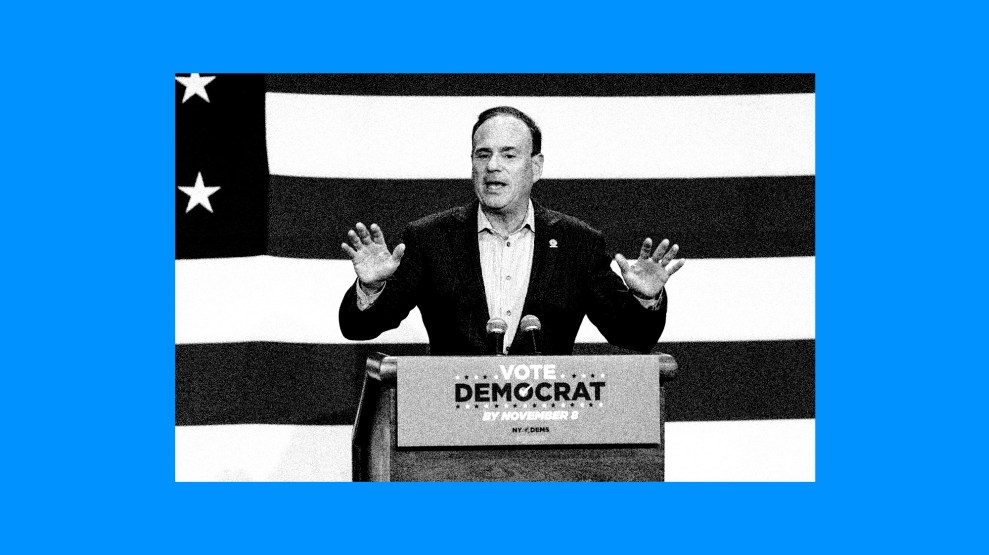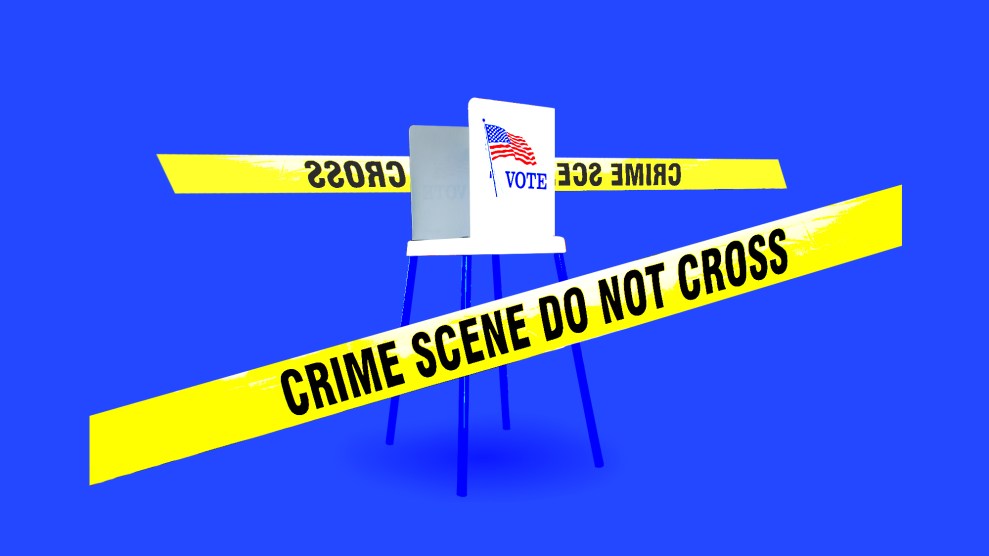
Jay Jacobs, the New York State Democratic Party chair.Lev Radin/Sipa/AP
It was two weeks before the New York statewide June primary, when Erica Vladimer realized a powerful member of her own party was working against her.
Vladimer was campaigning to fill an open spot as a Democratic State Committee member in New York City’s 76th Assembly District, which represents the Upper East Side’s Yorkville and Roosevelt Island. The race typically only garners around 10 percent of citywide votes. Democratic State Committee members are ostensibly among the smallest building block of the Democratic Party: they vote on Democratic Party leadership; they select Democratic National Convention members; they choose local judicial candidates.
A New Jersey-native, when Vladimer first moved to the Upper East Side, she got involved in her local political club. There, she met former State Committee member Lauren Trapanotto—the two bonded over concerns the State Democratic Party was not doing enough to represent the deep-blue state. “There seemed to be this growing connection I couldn’t ignore,” Vladimer said. When Trapanotto stepped down, Vladimer decided to run for the position.
It wasn’t until late in the race that Vladimer had challengers. In the eleventh hour, Joyce Short and Marc Jonas Block entered the contest. The two were less progressive. Short told voters that if they supported defunding the police she was “not your girl.” Block said he did not believe the city should get rid of standardized testing for Gifted & Talented school programs, an application process criticized for fueling segregation. He was was also against Defund.
But, despite their late joining, the two newcomers had a key advantage: Jay Jacobs, the New York State Democratic Party chair, had maxed out donations to support the last-minute candidates.
As Patch reported, financial disclosures showed the newcomers had raised $24,100 in donations from Jacobs, his wife, and two other New Jersey and Long Island-based couples who had previously donated to members of the Republican Party.
For Vladimer, it was indicative of the problems she was attacking with her campaign. “Jay has been very out of touch with the Democratic party and where it’s going—and that was a big part of our campaign,” Vladimer said. “I have to assume he got wind of that and decided to fund our opponents who would’ve been more of his cronies.”
Jacobs says that he had not met Vladimer or Jeremy Berman, Vladimer’s running mate. (Candidates run in pairs for the Committee). Still, Jacobs felt that their “unprovoked negative campaign” gave him the impetus to oppose them, he said in a statement.
“The platform of those candidates was to see that I was removed as Chairman,” he told Mother Jones via email. “As an American citizen, it is my Constitutional right to spend my own personal money as I see fit.”
In addition to giving examples of his personal spending, Jacobs detailed the party’s fundraising efforts for 2021 down-ballot candidates and this year’s midterm elections.
Despite the last-minute fundraising move, Vladimer and Berman won their primary in June.
Within a few months, critiques of Jay Jacobs would be pulled into a much larger spotlight. The midterm election season was a disappointment for New York State Democrats. Republicans flipped four congressional seats in New York—more than in Ron DeSantis’ Florida. The Democratic loss of the House of Representatives has been blamed on New York.
As Ross Barkan wrote for the Atlantic, critics have wed the losses to the legacy of former Democratic governor Andrew Cuomo, a weak gubernatorial campaign, and infighting among politicians about how to tackle—and talk about—fears of crime. Each, though, comes back to a core issue, frequently raised by the progressive flank of the party, and now others: A New York State party leadership that has neglected its grassroots.
The state’s Red wave has drawn national attention and spotlighted Blue failings.
Vladimer has seized the chance. Just days after the midterm election she organized a statement calling for Jacobs’ resignation, citing mismanagement of the State Democratic Party as the reason for the Democratic losses.
“It’s time for change. It’s not enough to just talk about it, we actually have to do it,” she said. “We wanted to put something together where enough people felt like it resonated with them, even outside of the State Committee, and that they would wanna add their voices to it.”
One common refrain after the midterm loss was that New York Democrats had fallen victim to redistricting. The new New York maps, released in May, were drawn by a special master who was appointed after conservative judges threw out drafts by the Democratic legislature that they considered to be a partisan gerrymander. The special master’s maps created new district lines with eight competitive congressional districts—resulting in more toss-ups, pitting incumbents against one another, and, at times, failing to prioritize communities of interest. The disorganized process, critics say, is a direct result of imprecise 2014 redistricting reforms signed off on by Cuomo, and the dismissal of 2021 ballot measures that looked to improve them, by the state’s chair, Jacobs.
In 2014, New York implemented redistricting reforms, which aimed to create an independent commission to oversee the process. It was part of a national trend to remove bias from creating maps and curb gerrymandering. In states like California and Michigan, reforms created an independent redistricting commission, in which maps are chosen by a neutral body and passed by them. But, according to Michael Li, a redistricting expert at the Brennan Center, New York’s commission did not follow this route.
The 2014 redistricting reforms were written primarily by Republicans, with the idea that they could “throw a wrench into the [redistricting] process if they didn’t like the way in which it was proceeding,” Susan Lerner, executive director of the watchdog group Common Cause, explained. “Cuomo acquiesced.”
It was one of many examples of how the former governor, Lerner said, “did many things which basically advantaged Republicans and disadvantaged particularly the more progressive aspect of the Democratic Party” in order to retain his own power.
The politics of the map process changed in 2018, when Democrats in New York took control of both chambers in Albany. Prior to that, the state government was divided and the parties had two choices: compromise or let a court draw the map. At the time, the latter was unappealing—neither party wanted to lose control of the process. But by 2021, Democrats no longer needed to compromise. For Republicans, Li said, “all of a sudden it looked better for a court to draw the map, and so [they] have an incentive to deadlock the process.”
Common Cause and other grassroots groups saw the writing on the wall. They drafted state ballot measures in 2021 that, among other things, sought to clarify the redistricting process, which they say was deliberately left open. One of the measures, Proposition 1, would have specifically clarified a number of faults in the redistricting process from 2014, according to Lerner.
With limited resources, the redistricting working group, made up of New York-based grassroots organizations, focused efforts on direct contact with voters, totaling 300,000 conversations according to Melody Lopez, executive director of New York Civic Engagement Table.
Billionaire cosmetics businessman Ron Lauder spent a minimum of $3 million opposing the measures, including a statewide “Just Say No” campaign headed by New York State Republican Committee Chair Nick Langworthy. (In 2022, Lauder also spent $11 million to support Republican gubernatorial nominee Lee Zeldin who came within 5 percentage points of Gov. Kathy Hochul.)
Struggling against a forceful and well-funded opposition, Lerner said Common Cause reached out to the State Democratic Party for support. “We were ignored,” she said. When asked why the party didn’t invest resources for the measures, Lerner said she had, “absolutely no idea.”
“It raises questions regarding the purpose of a political party. Is it to aggregate money for the incumbent? Or is it to help like-minded individuals develop the policies that they want to see adopted and allow people to organize around issues which are important to them?” she asked.
The redistricting reform measure failed in November 2021 with almost 50 percent of voters in and outside New York City voting “no” on the measure. Lerner notes that there were other substantial pro-democracy ballot measures that would have allowed no-fault absentee voting and same-day registration for New Yorkers. The pro-voter measures were also shot down, disenfranchising tens of thousands of New Yorkers by leaving in place one of the earliest registration cut-offs in the country, according to NYCLU.
In an email, Jacobs said that this is the first time he’s heard the Common Cause claim. “As far as I know, that is just simply false. Who did they reach out to? Who ignored them? No one called me or my Executive Director.”
The New York State Democratic Party does not historically get involved in promoting or opposing ballot referenda, according to Jacobs. After Lauder waged a last-minute campaign against the measures, Jacobs said the party was asked by the Democratic Senatorial Campaign Committee (DSCC) “to send emails and include a pitch to vote YES in any mail we were already sending out. We did send out emails but had no mail in the hopper. We are a HOUSEKEEPING entity,” he wrote.
A “certain elected official” decided to blame the state party for the loss to “deflect their own culpability,” Jacobs continued. “I might point out that this year the Environmental Bond Act passed as a referendum. I am still waiting to be thanked for that referendum passing.”
Post-midterms, New York Democrats are split on how to move forward.
There’s a tendency to want to blame Democratic losses on the maps, according to Michael Li at the Brennan Center. “But, the seat that Democrats lost on Long Island is more democratic under a special master’s map than it was under the map that Democrats originally drew,” Li said. “If Democrats in New York had simply performed as well as Democrats in Kansas, they would’ve held all those seats.”
He, like others, believe the Cuomo-era reforms are problematically designed and should be revised further, but that Democrats need to examine how their state party functions first and foremost. “There needs to be a lot of soul searching because there are many steps that led us here and their fingerprints are all over the murder weapon.”
Vladimer and like-minded progressives are focused on reforming the party starting with the chair. Simple grassroots changes could be made, they believe.
For example, the Working Families Party mobilized in the last weeks of the midterm election after hearing from elected officials who did not have any literature from the Democratic Party. In the final weeks, “Over 40 elected officials joined and we gave them various assignments and marching orders,” said Ravi Mangla, the Communications Manager for the New York Working Families Party, “because that kind of coordination or support was not happening from the New York State Democratic Party.”
Still, New York Democrats saw some bright spots in the midterms. According to Ulster County Chairman Kelleigh McKenzie, her county faired well on election night. Democratic Rep. Pat Ryan won.
But that wasn’t to the state party’s credit. McKenzie says their success came from a bottom-up approach and grassroots infrastructure, something she says the state party is lacking.
“I’m on the executive committee of the state party. I’m also a state committee member, and I’m a county chair, and I was never even asked to weigh in or give input on the statewide coordinated campaign plan. I had no knowledge of it.” McKenzie said.
The lack of transparent communication and cross-pollination on the ground are crucial weaknesses in the State Democratic Party, according to McKenzie. A coordinated campaign office that was set up as a hub for phone banking, volunteer recruitment, and the like, for congressional candidate Josh Riley and State Senator Michelle Hinchey had heard from an Ulster County Democratic Committee member that a local committee wasn’t able to afford its own space this year. The campaign office offered to let the local committee operate out of their space. Even though the office was set up 30 minutes down the road in her county, McKenzie only heard about the offer once a member from her local committee mentioned that they had set up shop.
“I appreciate the support that the state party did give in select areas of the state,” she said. “My issue is that they did it in a vacuum without involving all of the voices of the people who were on the ground.”
In a statement to Mother Jones Jacobs wrote, “We have held more County Chair meetings (by Zoom) than ever before. I have repeatedly spoken to the Chairs (and I spoke at the Fall State Committee Meeting) about our Coordinated Campaign and let those who attended know what we were doing.”
McKenzie is part of a coalition of Hudson Valley Party chairs. Their group did not sign on to the statement calling for Jay Jacobs resignation or the subsequent statement of support from county chairs that was shared days later. Instead, the group has called for grassroots reforms to the state party including internal communications infrastructure and annual budget and fundraising plans to financially support counties statewide.
This feeling that the party assumes it will and has been dysfunctional is widespread.
“I’m in New York and I don’t get communications from the New York Democratic Party,” said Alexis Grenell, a political consultant. She did, however, receive literature from Wisconsin. “No one thinks that Jay Jacobs and the Democratic Party are gonna become an arm of the Democratic Socialists of America,” Grenell continued, but they should be doing the basics, like supporting candidates and investing in pro-democracy ballot initiatives that data show favor Democrats.
This would look like other states with a “functioning state party that serves to provide infrastructure to candidates, get people elected and inform democrats that there’s even an election.”
This seems extremely possible to McKenzie. “There are a lot of rural counties and upstate counties whose local and county committees really do need a lot more support, energy and revitalization,” she explained. “It truly is such an easy lift to make this a priority and a focus.”
Correction, December 6: An earlier version of this story did not specify that the group in need of office space was one of the many local committees that make up the Ulster County Democratic Committee.










